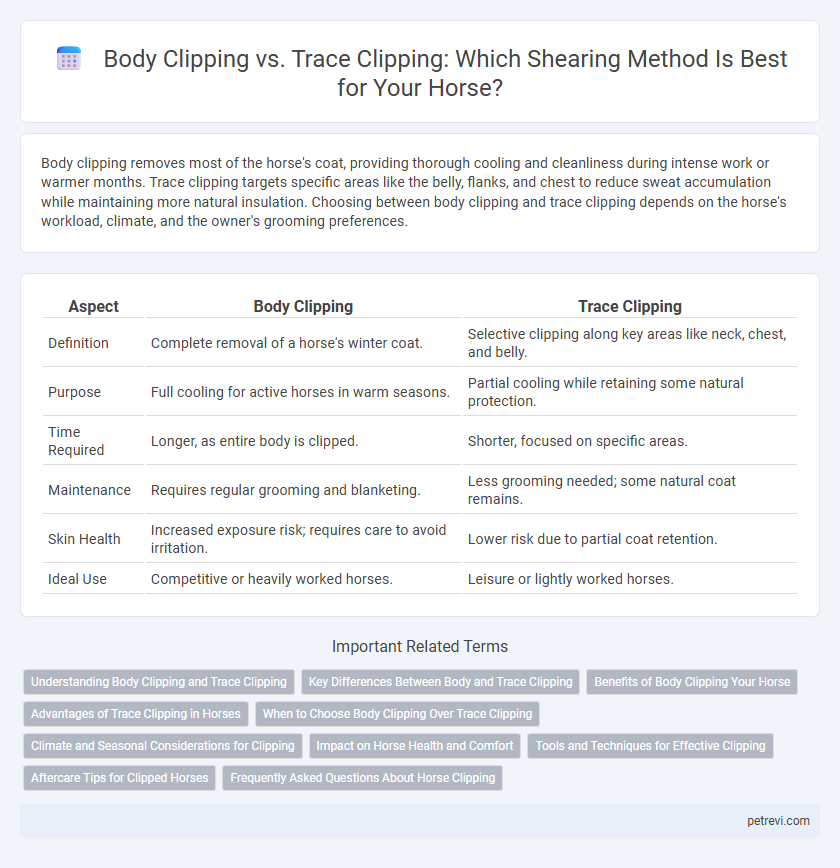Body clipping removes most of the horse's coat, providing thorough cooling and cleanliness during intense work or warmer months. Trace clipping targets specific areas like the belly, flanks, and chest to reduce sweat accumulation while maintaining more natural insulation. Choosing between body clipping and trace clipping depends on the horse's workload, climate, and the owner's grooming preferences.
Table of Comparison
| Aspect | Body Clipping | Trace Clipping |
|---|---|---|
| Definition | Complete removal of a horse's winter coat. | Selective clipping along key areas like neck, chest, and belly. |
| Purpose | Full cooling for active horses in warm seasons. | Partial cooling while retaining some natural protection. |
| Time Required | Longer, as entire body is clipped. | Shorter, focused on specific areas. |
| Maintenance | Requires regular grooming and blanketing. | Less grooming needed; some natural coat remains. |
| Skin Health | Increased exposure risk; requires care to avoid irritation. | Lower risk due to partial coat retention. |
| Ideal Use | Competitive or heavily worked horses. | Leisure or lightly worked horses. |
Understanding Body Clipping and Trace Clipping
Body clipping involves shaving the entire horse's coat to maintain hygiene and regulate temperature during intense work periods, promoting better muscle definition and reducing sweat accumulation. Trace clipping targets specific areas like the chest, belly, and legs, minimizing exposure while preserving the protective coat on less sweat-prone regions, ideal for horses with lighter exercise routines. Selecting between body and trace clipping depends on the horse's workload, climate, and grooming needs, ensuring optimal comfort and coat health throughout the season.
Key Differences Between Body and Trace Clipping
Body clipping removes a horse's entire coat for thorough cooling, while trace clipping targets only sweat-prone areas such as the belly, chest, and neck to maintain some insulation. Body clipping requires more time and effort but is ideal for horses in heavy work or during winter to prevent overheating and sweating-related issues. Trace clipping is less extensive, preserving natural coat protection while reducing sweat patches and allowing easier drying after exercise.
Benefits of Body Clipping Your Horse
Body clipping your horse removes the entire winter coat, providing better temperature regulation during intense workouts and preventing overheating. This method reduces drying time after exercise, minimizing the risk of skin infections and improving overall hygiene. Body clipping also allows for easier grooming and enhances the effectiveness of cooling strategies, promoting optimal health and performance.
Advantages of Trace Clipping in Horses
Trace clipping in horses offers targeted removal of sweat-prone areas, enhancing cooling during exercise without fully stripping the coat's natural protection. This method reduces the risk of skin irritation and helps maintain the horse's temperature regulation in variable climates. Trace clipping also saves time and resources compared to full body clipping, making it a practical choice for active horses.
When to Choose Body Clipping Over Trace Clipping
Body clipping is ideal for horses with dense winter coats in harsh climates, especially before intense exercise or showing, as it provides thorough sweat removal and improves cooling. Trace clipping suits mild weather or less frequent work but fails to manage heavy sweating effectively during rigorous activity. Choosing body clipping over trace clipping ensures optimal hygiene and comfort during demanding performance periods, reducing risks of skin infections and overheating.
Climate and Seasonal Considerations for Clipping
Body clipping removes the entire winter coat, making it ideal for horses working intensely in cold climates during winter, preventing overheating and reducing sweat buildup. Trace clipping targets specific areas, such as under the saddle and along the neck, preserving body warmth, which suits milder climates or horses with lighter workloads. Seasonal considerations include fully clipping horses in late fall before winter sets in and opting for trace clipping in early winter or spring to balance warmth retention and sweat management.
Impact on Horse Health and Comfort
Body clipping removes a horse's entire winter coat, significantly reducing sweat and the risk of chills during exercise, which helps maintain optimal body temperature and prevents skin irritations. Trace clipping targets only specific areas like the neck and chest, preserving most of the natural coat while allowing heat dissipation in high-sweat zones, thereby minimizing the risk of overheating without exposing the horse to cold stress. Choosing the appropriate clipping method based on workload and climate enhances the horse's comfort, reduces respiratory strain, and supports overall health throughout changing weather conditions.
Tools and Techniques for Effective Clipping
Body clipping requires powerful electric clippers with wide blades to remove large areas of hair quickly, while trace clipping uses finer clippers for detailed grooming around the horse's legs, face, and saddle areas. High-quality, sharp blades and proper clipper lubrication are essential for smooth, efficient clipping and to prevent skin irritation. Employing steady, consistent strokes and maintaining the right blade speed enhances the precision and safety of both body and trace clipping techniques.
Aftercare Tips for Clipped Horses
Body clipping removes the horse's entire coat, requiring careful aftercare such as providing blankets to maintain warmth and prevent chills, especially in colder climates. Trace clipping focuses on trimming specific areas, meaning targeted grooming and monitoring sweat-prone regions are essential to avoid skin irritation. Regularly checking the clipped areas for dryness or irritation and using moisturizing sprays can help maintain skin health and promote comfort for the horse.
Frequently Asked Questions About Horse Clipping
Body clipping removes large areas of hair on a horse for easier grooming and better temperature regulation, while trace clipping targets key sweat zones like the chest and throatlatch to reduce overheating during exercise. Horse owners ask how often clipping should be done, with most recommending every 4-6 weeks during heavy work seasons to prevent coat regrowth from causing discomfort. Questions also focus on best tools for clipping, where electric clippers with adjustable blades provide precision, and on post-clipping care to maintain skin health and prevent irritation.
Body Clipping vs Trace Clipping for Horse Shearing Infographic

 petrevi.com
petrevi.com